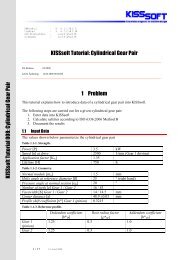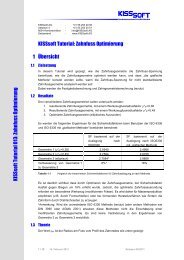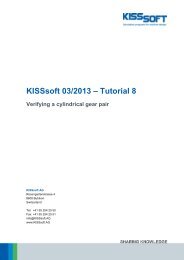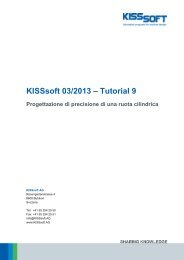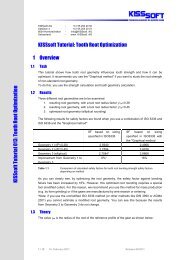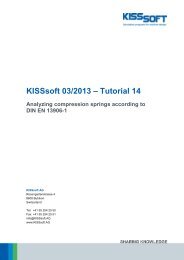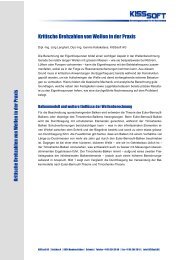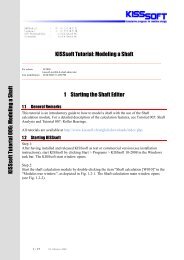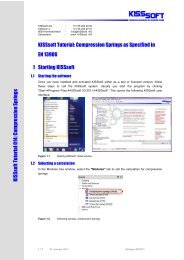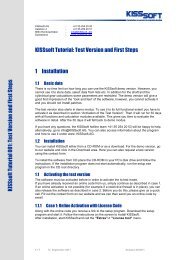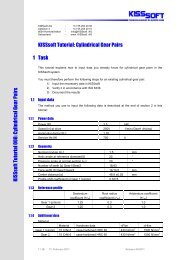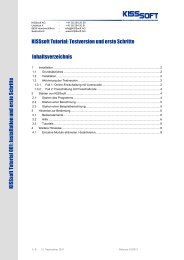Book template - KISSsoft AG
Book template - KISSsoft AG
Book template - KISSsoft AG
You also want an ePaper? Increase the reach of your titles
YUMPU automatically turns print PDFs into web optimized ePapers that Google loves.
Chapter 1 I-38 Description of the calculation modules<br />
pressure lubricated bearings. It calculates all the operating data in accordance<br />
with DIN 31653, including the operating temperature, minimum lubrication<br />
gap width, power loss, oil flow etc.<br />
Calculation according to DIN 31654: Complete calculation of tilting-pad thrust<br />
bearings according to 31654, parts 1 to 3 (1991 edition) for pressure-less and<br />
pressure lubricated bearings. This takes into account the way in which lubricant<br />
is applied (lubrication holes, lubrication groove, lubrication glands). It calculates<br />
all the operating data in accordance with DIN 31654, including the operating<br />
temperature, minimum lubrication gap width, power loss, oil flow etc.<br />
3.28 W10 Tooth trace correction<br />
Calculates the shift of a cross-section point from its home position due to torsion<br />
and bending. For various purposes, for example, for grinding off crowning (also<br />
called length or flank line correction) on toothing, it is important that you know<br />
how much a specific point in the shaft cross-section moves in a particular direction<br />
due to elastic deformation. This program calculates the shift in a specific interval<br />
along the length of the axis and prints out the data. The tooth trace deviation due to<br />
deformation is also calculated for toothing. This value is needed for precise cylindrical<br />
gear calculations. Graphical display of deformation components on screen<br />
(and printer). You can transfer this data to any CAD program via the graphic interface.<br />
3.29 W12 Shaft arrangement (integrated d e-<br />
sign tool)<br />
Shaft sizing:<br />
The system has two functions which you can use to size shafts (of any diameter):<br />
Sizing for strength: The <strong>KISSsoft</strong> system arranges the shaft contour so that the<br />
equivalent stress has the same (definable) value in all the cross-sections.<br />
Sizing for deflection: The <strong>KISSsoft</strong> system changes the diameters of the default<br />
shaft contour proportionally to achieve a pre-defined maximum deflection.<br />
Procedure shaft optimization:<br />
The "traditional" method of design leads from the idea to the design to rough-sizing<br />
and then to the draft design. This can be replicated very effectively by the <strong>KISSsoft</strong><br />
system when it is implemented in a CAD environment. As soon as a design concept<br />
is available, the next step usually involves dimensioning the load bearing elements,<br />
such as couplings, gears, belts etc. The <strong>KISSsoft</strong> system provides a wide<br />
range of layout programs for this. The dimensions of the load bearing elements<br />
then result in the bearing distances and the shaft lengths. The <strong>KISSsoft</strong> system has



